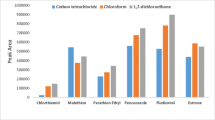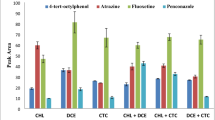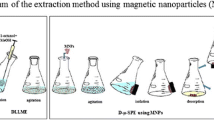Abstract
The need to enhance food safety has led to major advancements in pesticide productions, and though many benefits have been gained, environmental contamination has also risen from these chemicals that tend to persist in the environment. Some pesticides, together with other chemicals commonly called endocrine disruptor compounds, block the receptor sites of hormones or mimic displaced hormones, leading to imbalanced hormonal levels that result in health disorders and diseases. These chemicals occur at trace levels and are not directly detected by conventional analytical methods. A dispersive liquid-liquid microextraction method was therefore developed for preconcentration of 12 analytes including hormones, endocrine disruptor compounds, and pesticides, to be analyzed by gas chromatography mass spectrometry. This was achieved by optimizing parameters such as extractor solvent type and amount, dispersive solvent type and amount, pH, and salt effect that affect extraction output. The limits of detection and quantification of the developed method were between 0.09 and 3.36 and 0.31 and 11.19 ng mL−1, respectively. The calibration plots of the analytes also showed good linearity and low percent relative standard deviations. Recovery studies were performed for tap water and wastewater samples, and the percent recoveries recorded were between 84 and 109%.


Similar content being viewed by others
References
Aktar, M. W., Sengupta, D., & Chowdhury, A. (2009). Impact of pesticides use in agriculture: their benefits and hazards. Interdisciplinary Toxicology, 2, 1–12.
Anjos, J. P., & Andrade, J. B. (2014). Determination of nineteen pesticides residues (organophosphates, organochlorine, pyrethroids, carbamate, thiocarbamate and strobilurin) in coconut water by SDME/GC–MS. Microchemical Journal, 112, 119–126.
Bakaraki, N., Chormey, D. S., Bakirdere, S., & Engin, G. O. (2016). Development of a sensitive liquid–liquid extraction method for the determination of N-butyryl-L-homoserine lactone produced in a submerged membrane bioreactor by gas chromatography mass spectrometry and deuterated anthracene as the internal standard. Analytical Methods, 8, 2660–2665.
Benedetti, D., Nunes, E., Sarmento, M., Porto, C., Santos, C. E. I., Dias, J. F., & Silva, J. (2013). Genetic damage in soybean workers exposed to pesticides: evaluation with the comet and buccal micronucleus cytome assays. Mutation Research, 752, 28–33.
Botaro, D., Torres, J. P. M., Malm, O., Rebelo, M. F., Henkelmann, B., & Schramm, K. W. (2011). Organochlorine pesticides residues in feed and muscle of farmed Nile tilapia from Brazilian fish farms. Food and Chemical Toxicology, 49, 2125–2130.
Cai, J., Zhu, F., Ruan, W., Lui, L., Lai, R., Zeng, F., & Ouyang, G. (2013). Determination of organochlorine pesticides in textiles using solid phase microextraction with gas chromatography-mass spectrometry. Microchemical Journal, 110, 280–284.
Cooper, J., & Dobson, H. (2007). The benefits of pesticides to mankind and the environment. Crop Protection, 26, 1337–1348.
Damalas, C. A., & Eleftherohorinos, I. G. (2011). Pesticide exposure, safety issues, and risk assessment indicators. International Journal of Environmental Research and Public Health, 8, 1402–1419.
Dobrowska, J. S., Erarpat, S., Chormey, D. S., Pyrzyńska, K., & Bakırdere, S. (2016). A novel liquid-liquid extraction for the determination of nicotine in tap water, wastewater and saliva at trace levels by GC-MS. Journal of AOAC International, 99, 806–812.
Fantke, P., Friedrich, R., & Jolliet, O. (2012). Health impact and damage cost assessment of pesticides in Europe. Environment International, 49, 9–17.
Gerber, R., Smit, N. J., Van Vuren, J. H. J., Nakayama, S. M. M., Yohannes, Y. B., Ikenaka, Y., Ishizuka, M., & Wepener, V. (2016). Bioaccumulation and human health risk assessment of DDT and other organochlorine pesticides in an apex aquatic predator from a premier conservation area. The Science of the Total Environment, 550, 522–533.
Gosain, A. K., Rao, S., & Basuray, D. (2006). Climate change impact assessment on hydrology of Indian river basins. Current Science, 90, 3.
Grimalt, S., & Dehouck, P. (2016). Review of analytical methods for the determination of pesticide residues in grapes. Journal of Chromatography A, 1433, 1–23.
Grung, M., Lin, Y., Zhang, H., Steen, A. O., Huang, J., Zhang, G., & Larssen, T. (2015). Pesticide levels and environmental risk in aquatic environments in China—a review. Environment International, 81, 87–97.
Gui, W., Tian, C., Sun, Q., Li, S., Zhang, W., Tang, J., & Zhu, G. (2016). Simultaneous determination of organotin pesticides by HPLC-ICP-MS and their sorption, desorption, and transformation in freshwater sediments. Water Research, 95, 185–194.
Hassan, J., & Sarkouhi, M. (2016). Miniaturized counter current liquid–liquid extraction for organophosphorus pesticides determination. Arabian Journal of Chemistry, 9, 38–42.
Health Canada. (2014). Guidelines for Canadian Drinking Water Quality—summary table. Water and Air Quality Bureau, Healthy Environments and Consumer Safety Branch, Health Canada, Ottawa, Ontario.
Hecker, M., & Hollert, H. (2011). Endocrine disruptor screening: regulatory perspectives and needs. Environmental Sciences Europe, 23, 15.
Hillocks, R. J. (2012). Farming with fewer pesticides: EU pesticide review and resulting challenges for UK agriculture. Crop Protection, 31, 85–93.
Jensen, P. K., & Olesen, M. H. (2014). Spray mass balance in pesticide application: a review. Crop Protection, 61, 23–31.
Karabelas, A. J., Plakas, K. V., Solomou, E. S., Drossou, V., & Sarigiannis, D. A. (2009). Impact of European legislation on marketed pesticides—a view from the standpoint of health impact assessment studies. Environment International, 35, 1096–1107.
Komesli, O. T., Bakırdere, S., Bayören, C., & Gökçay, C. F. (2012). Simultaneous determination of selected endocrine disrupter compounds in wastewater samples in ultra trace levels using HPLC-ES-MS/MS. Environmental Monitoring and Assessment, 184, 5215–5224.
Komesli, O. T., Muz, M., Ak, M. S., Bakırdere, S., & Gökçay, C. F. (2016). Comparison of EDCs removal in full and pilot scale membrane bioreactor plants: effect of flux rate on EDCs removal in short SRT. Journal of Environmental Management. doi:10.1016/j.jenvman.2016.06.004.
Li, J., Chen, C., & Li, F. (2016). Status of POPs accumulation in the Yellow River Delta: from distribution to risk assessment. Marine Pollution Bulletin, 107, 370–378.
Misra, A. K. (2014). Climate change and challenges of water and food security. International Journal of Sustainable Built Environment, 3, 153–165.
Mnif, W., Hassine, A. I. H., Bouaziz, A., Bartegi, A., Thomas, O., & Roig, B. (2011). Effect of endocrine disruptor pesticides: a review. International Journal of Environmental Research and Public Health, 8, 2265–2303.
Morgan, D., & Tsai, S. C. (2015). Sleep and the endocrine system. Critical Care Clinics, 31, 403–418.
Mostafalou, S., & Abdollahi, M. (2013). Pesticides and human chronic diseases: evidences, mechanisms, and perspectives. Toxicology and Applied Pharmacology, 268, 157–177.
Muz, M., Sönmez, M. S., Komesli, O. T., Bakırdere, S., & Gökçay, C. F. (2012). Determination of selected natural hormones and endocrine disrupting compounds in domestic wastewater treatment plants by liquid chromatography electrospray ionization tandem mass spectrometry after solid phase extraction. Analyst, 137, 884–889.
Neghab, M., Momenbella-Fard, M., Naziaghdam, R., Salahshour, N., Kazemi, M., & Alipour, H. (2014). The effects of exposure to pesticides on the fecundity status of farm workers resident in a rural region of Fars province, southern Iran. Asian Pacific Journal of Tropical Biomedicine, 4, 324–328.
Rezaee, M., Assadi, Y., Milani Hosseini, M. R., Aghaee, E., Ahmadi, F., & Berijani, S. (2006). Determination of organic compounds in water using dispersive liquid–liquid microextraction. Journal of Chromatography. A, 1116, 1–9.
Rezg, R., Mornagui, B., El-Fazaa, S., & Gharbi, N. (2010). Organophosphorus pesticides as food chain contaminants and type 2 diabetes: a review. Trends in Food Science and Technology, 21, 345–357.
Skevas, T., Oude Lansink, A. G. J. M., & Stefanou, S. E. (2013). Designing the emerging EU pesticide policy: a literature review. NJAS - Wageningen Journal of Life Sciences, 64, 95–103.
Songa, E. A., & Okonkwo, J. O. (2016). Recent approaches to improving selectivity and sensitivity of enzyme-based biosensors for organophosphorus pesticides: a review. Talanta, 155, 289–304.
Sönmez, M. S., Muz, M., Komesli, O. T., Bakırdere, S., & Gökçay, C. F. (2012). Determination of selected endocrine disrupter compounds at trace levels in sewage sludge samples. Clean-Soil, Air, Water, 40, 980–985.
Zhao, X., Zhou, Y., Kong, W., Gong, B., Chen, D., Wei, J., & Yang, M. (2016). Multi-residue analysis of 26 organochlorine pesticides in Alpinia oxyphylla by GC-ECD after solid phase extraction and acid cleanup. Journal of Chromatography B, 1017-1018, 211–220.
Acknowledgements
The authors duly acknowledge Yıldız Technical University for the financial support (Scientific Research Project, 2016-01-02-KAP04).
Author information
Authors and Affiliations
Corresponding author
Additional information
Highlights
• A dispersive liquid-liquid microextraction method was developed for the preconcentration of 12 analytes
• All of the system parameters were optimized.
• The limits of detection and quantification of the developed method were between 0.09 and 5.69 and 0.31 and 18.96 ng mL−1, respectively
• The spiking experiment at different concentrations revealed satisfactory recoveries for tap water and wastewater.
Rights and permissions
About this article
Cite this article
Chormey, D.S., Büyükpınar, Ç., Turak, F. et al. Simultaneous determination of selected hormones, endocrine disruptor compounds, and pesticides in water medium at trace levels by GC-MS after dispersive liquid-liquid microextraction. Environ Monit Assess 189, 277 (2017). https://doi.org/10.1007/s10661-017-6003-6
Received:
Accepted:
Published:
DOI: https://doi.org/10.1007/s10661-017-6003-6




